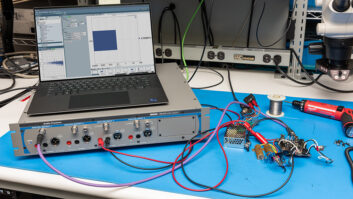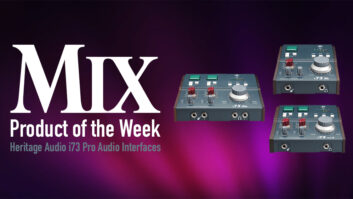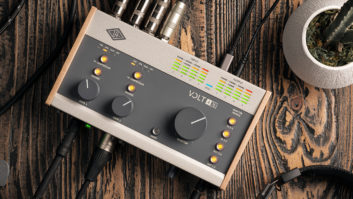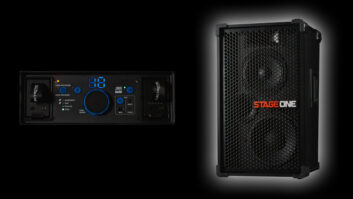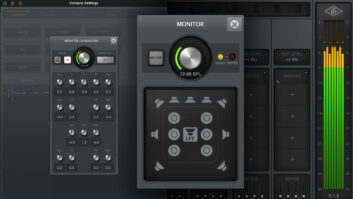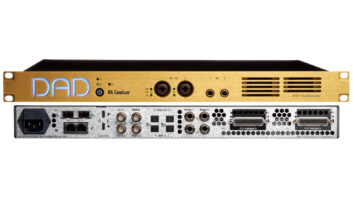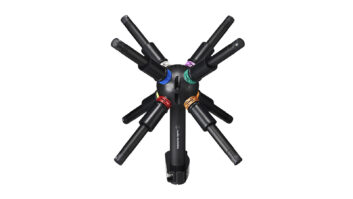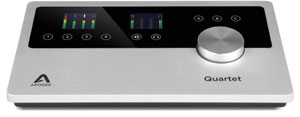
Apogee’s Quartet offers a range of features and recording possibilities for portable and mobile use.
When it comes to digital audio hardware, there seem to be two different classes: devices offering the most connections, features and best possible sample rates for the most affordable price, and hardware that shoots for the highest possible sound quality regardless of the resulting price. Apogee has always embraced the latter approach, taking great care to consider every component’s role, from clocking, to converters, to power supply, and the quality and cleanliness of the analog portion of D/A and A/D converters.
With the introduction of the original Duet interface, Apogee announced its presence to musicians and home recordists. Since then, the company has extended its line to include the One and the Quartet, offering varying amounts of I/O and catering to engineers working on a smaller scale without sacrificing sound quality. The latest development has been a push into a whole new market, which has seen a surprisingly small amount of attention from hardware manufacturers: iOS compatibility. With the latest firmware update, Quartet is now iOS compatible, and a brand new incarnation of One has been developed that can also connect to directly to iPhones, iPods and iPads with no extra connection kit.
Quartet
The Quartet is a compact, multi-function audio interface that sits stylishly on a desktop. The build quality is impressive, with a chassis made of steel and aluminum. While the back panel is packed with connectors, the ergonomically angled top surface is clean, simple and stylish, presenting only the essential controls. Besides the miniature USB connector for connecting Quartet to a Mac, PC or iOS device, the back panel includes a USB port designed to allow a MIDI device to be chained through the unit to the host device. When using Quartet with Pro Tools on a MacBook Pro, one USB slot is eaten up by an iLok, so the ability to connect the Quartet and a MIDI keyboard through the remaining port is very handy. Considering that iOS devices either have a single 30-pin connector, or a lightning port, this becomes an even bigger plus.
Audio connections include four XLR/TRS combo input jacks that can accept mic signals (while optionally providing phantom power), line-level signals, or instruments. Six balanced ¼-inch TRS output jacks can be configured for a variety of uses, outputting either +4 dBu or -10 dBv. Two digital Toslink input jacks, allow up to eight channels of ADAT input even at 96 kHz, using SMUX. A word clock output is provided in order to use the high-quality Apogee clock to sync the digital source that is feeding the optical input. There is also a ¼-inch TRS headphone jack on the side. Altogether, it has 12 inputs and six outputs, plus the stereo headphone output.
The only other connector on the back is the jack for the power supply. The power supply is absolutely necessary, as the Quartet cannot be USB bus-powered by iOS devices or computers. USB power can be unpredictable, and Apogee certainly knows that, but I found this a little disappointing considering that one of the biggest draws of iOS-based recording would be extreme portability. So you can’t really use this setup for recording sound effects in the field, or for Alan Lomax-style prison recordings, but it will charge your iOS device while connected.
The top surface features a large, multi-function knob common to all of the smaller Apogee interfaces. On the left are four large meters corresponding to each of the four analog inputs, and above each one is an icon indicating whether it is set to mic, line or instrument mode. Pressing any of the four numbered touchscreen buttons below the meters will appropriate the multi-function knob to control that channel’s input gain. To the right of that are three stereo output meters and a meter displaying the signal feeding the headphone jack. Buttons below these meters allow the large knob to control headphone output level or speaker output level. Above the knob are three buttons labeled A, B and C. The included Maestro software controls these buttons’ functions, as well as a good deal of the unit’s other functionality.
Maestro
Quartet will plug and play, and work with the CoreAudio driver on a Mac without installing any software. You can even control most of the basic functions of the unit using the front panel controls. However, to maximize Quartet’s full potential, Maestro software is necessary. Maestro provides predictable, basic features like choosing output level or engaging Apogee’s signature Soft Limit function, which rounds off the tips of transients that would otherwise clip. Besides the basics, there is a real wealth of flexibility and customization that I’ve found absent in similar products’ software control panels.
The six analog outputs can be used in so many different ways. They can be used to feed six separate outputs from your recording software to six separate inputs of an analog mixer, in their most basic configuration. Along with the main output mix, the Maestro software provides two additional optional software mixers. Each can create a balance of any or all of the zero-latency input signals plus one of eight stereo software returns. With that, an artist’s mix can be built using DAW sends to software returns 7-8, for example, plus the artist can hear a zero-latency version of the vocal performance; this can all be mixed in Maestro Mixer 1. That mix can be routed to the headphone jack. Meanwhile, the engineer can build a mix with DAW sends to software return 1-2 and include the post-conversion vocal with plug-ins on the track. That mix can be fed to physical outputs 1-2, which are feeding a pair of monitors.
Alternatively, the three pairs of outputs could be connected to three different pairs of monitors, each being fed the same mix, so the Quartet can act as a monitor controller. The A, B and C buttons can be mapped to each of the speaker pairs, so that A/B/C’ing the mix across different types of monitors is relatively simple. Yet another possibility is to group all six outputs into a 5.1 set and control the overall level of the surround mix feeding your 5.1 monitor setup with the big knob. With that, the A, B and C buttons can be repurposed to become dim, mute and mono sum buttons. The functionality of those three buttons is individually customizable, with all functions being offered along with things like clearing meter peaks, and a variety of toggling and muting functions. Whether you are using the Quartet for tracking, editing sound or video with 5.1 audio, or mixing, the ability to map the most commonly used functions is both comfortable and convenient. My only complaint is that engaging and disengaging phantom power always required a trip to Maestro, never from the surface itself.
One
While Quartet is like a more powerful, expanded version of the popular Duet, the One seems to be a more affordable version of Duet. While Duet provides two mic preamplifiers for 2-channel recording, as the name suggests, One provides one mic pre. While recording one miked signal, the One can also record an instrument simultaneously. The input situation gets slightly confusing when considering the fact that the One also has a built-in condenser microphone. This begs the question, “Can I use the built-in mic, plus the mic pre and an instrument?” The answer is not only “no,” but it seems that the built-in mic uses the mic preamp, so you can’t use the built-in mic plus another microphone. The only 2-channel combination is instrument plus either the built-in mic or an external mic. Considering that the device is called One, that’s still one more input than I was expecting.

Apogee’s One seems to be a more affordable version of the company’s Duet interface.
The One is very small and portable, only slightly larger than what you might call “pocket-sized.” The build is well above average. From the pictures, I assumed it was plastic, but I was surprised to find a sturdy aluminum chassis with a plastic and rugged rubber-backed panel. The top features a single multi-function knob, which also serves as a button. The top panel also shows four icons representing the built-in mic, an external mic, an external instrument and the headphone output jack. Below the mic and instrument icons are three-segment LED input meters. Pressing the knob/button toggles between lighting each of the four icons and chooses which feature the knob will control. This way, input gain can be adjusted, or the output level feeding the 1/8-inch headphone jack can be altered as well.
Portability
The One is powered by a pair of AA batteries. With that, an iPhone and a One will have you recording your music wherever you go. A mono input might be slightly less than desirable for sound effects recording, but the ability to record guitar plus voice with high-quality preamps and converters, wherever inspiration might strike, could save many creative ideas otherwise lost forever. I initially tried a pair of rechargeable NiMH batteries, but they seemed to under-power the One. A pair of full 1.5-volt alkaline batteries did the job, but when using phantom power, it seemed that the life was predictably short. I killed a few pairs before switching to the included power supply, which, like the Quartet’s power supply, passed power through to the iPad to which it was connected.
The only thing that makes the One a little clunky is similar to what many users had experienced with the Duet. The unit itself is too small for an XLR jack to exist anywhere on its body, so all the I/O breaks out from a small connector on the One to a pigtail snake. The snake, in this case, has a female TS connector and a female XLR connector for mic and instrument connections. The One comes with a mounting harness to attach itself to a mic stand when using the built-in mic. When setting the One up this way, dangling heavy cables from the breakout connector creates a lot of stress.
In Use
Using the Quartet on a Mac running Pro Tools or PreSonus Studio One was everything I expected it to be. There were no issues and the hardware played nicely with the software. Recording a performer singing and playing acoustic guitar in the same room with me, I could build a headphone mix for the artist using the Quartet’s headphone out. I used a pair of analog outputs to feed my own mix to my Dangerous Source, which allowed me to monitor with headphones while recording and then easily play my own mix through monitors during playback and rough mixing.
As expected, the preamps and converters sounded great. Naturally, everyone has their own opinions about converters, but for me the sound of Apogee converters pairs really nicely with acoustic instruments. The preamps and converters in the Quartet don’t sound like a cheap circuit with the Apogee name; they have that Apogee sound. Rather than just being honest and transparent, it would be fairer to say that nothing is lost, but they do seem to add a little sparkle to the top end. When capturing the subtleties of the creaks and finger drags and the little details that make an acoustic performance feel real, the preamps of the Quartet and the One leave nothing to be desired. The same could be said about the way they record vocals. With all the breath and humanity that they preserve, the recorded performance is really true to itself.
The real test, though, was to see how well they played with iOS devices. When it comes to the iPad, the possibilities for doing serious recording are limited by the small number of apps that have been developed for the iPad to date. I spent some time with the One and Quartet feeding GarageBand for iPad, but was most impressed with the potential when working with Auria from WaveMachine Labs. Auria seems to be the most powerful DAW currently available for iOS, offering up to 48 tracks of playback and up to 24 tracks of simultaneous recording. While there are only a limited number of plugins currently available, the basic channel strip and reverb were enough to get things started, and with automation, MTC and MMC compatibility, this app is more serious than anything that I expected to find running on an iPad.
Integration with the Quartet or One was a snap. Auria immediately recognized whichever piece of hardware was connected without the need to enter any kind of “playback engine” style menu. The inputs and outputs were mapped by default, but rerouting them was simple enough, if necessary, using a familiar staircase-like grid mapping matrix.
At first, I recorded an acoustic guitar with two mics, a singer and a harmonica. On this simple session, even when recording four inputs simultaneously, I was able to keep the input buffer small enough that latency wasn’t really an issue, so dealing with the Maestro mixer wasn’t really necessary. I tried making a large session with the maximum number of tracks just to see what would happen, and in that case, a maximum buffer setting was necessary for playback without errors. With that session, I experienced an issue repeatedly when leaving Auria to adjust settings in Maestro. When I would return to Auria, it seemed like there was a clocking error where audio was grainy and distorted and played back with ticks and pops. Quitting and restarting would resolve the problem, but it would soon return if I bounced back and forth between apps. By reducing the track count to 12, I rid the system of this problem entirely. It’s hard to say whether it was Auria, Maestro, or the hardware that was to blame, although it’s worth noting that I experienced the same issue with the Quartet and the One.
This same thing happened when using the One with GarageBand. I had my guitar connected to their virtual amplifier and everything would be working, but the wrong combination of switching between windows would cause that same grainy sound, and clicks and pops. After using the system for a while and keeping my track counts in Auria conservative, those problems went away and it was smooth sailing from there. I was able to track, overdub and do minor edits with comfort and ease. I really got to like the simple setup and found myself favoring the iPad setup over a laptop for most simple tracking sessions while it was around.
I look back at my experience tracking, and I would say that Apogee has successfully created a great-sounding solution for recording with an iPad. The one question that remains, however, is what is the significance of this? There are already high-end field recorders that can capture quality sound with great portability. One shortcoming of those devices, from a musical perspective, is that without the type of graphics you get from the edit window of a DAW, overdubbing and finding punch points is a bit tedious. So, clearly the idea was to create a portable solution with a great front end and an accurate back end with the visual feedback of a DAW. Despite the Quartet’s need to be connected to power, the whole setup can pack up and travel pretty easily, so I would say thumbs up there. Despite that, with Auria in its infancy, it’s hard to imagine taking a project from start to finish within the iPad environment, so doing away with your laptop or computer and using the iPad exclusively seems like a stretch.
Perhaps the greatest benefits, though, are ones that are easy to overlook. I’ve been in many situations where I’ve recorded music or sound effects in the same room as the computer that is capturing the sound. Computer fan noise is constantly an issue. On top of that, spacebar and mouse clicks have found a way into many a recording. The iPad eliminates both of these problems with its silent touchscreen and lack of fans. I can’t overstate the how valuable this silence can be.
Is It a Hit?
In general, the Quartet is a rock-solid music creation station. It’s serious, professional, looks fantastic and sounds even better. The features are just right, no frivolity. The iOS bonus just made it that much better. Besides that, if you’re a singer, guitarist, or any kind of solo musician who wonders why your recordings sound dull and muddy, wake up your music with the One. Its one quality input channel can certainly be a better buy than wasting money on eight mediocre ones.
The Apogee iOS-compatible devices are truly designed for straightaway iOS connection. While the Apogee line isn’t necessarily the first or only way to connect a quality interface to an iOS device, if you go with these products, you will certainly not be disappointed by their overall performance and sound.
Brandon Hickey as an independent audio engineer and educator.
Product Summary
COMPANY: Apogee
PRODUCT: Quartet; One
WEBSITE:apogeedigital.com
PRICES: Quartet $1,395 (street); One $349 (street)
PROS: Great-sounding preamps and converters. Solid build quality.
CONS: No USB bus powering; power supply is required.

